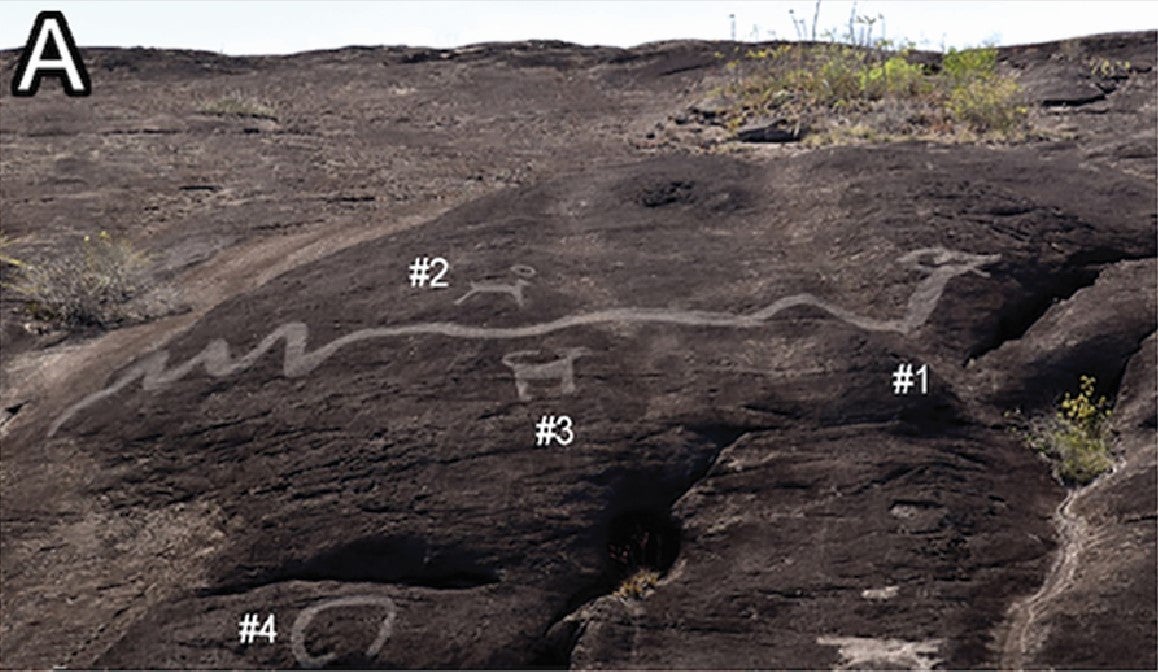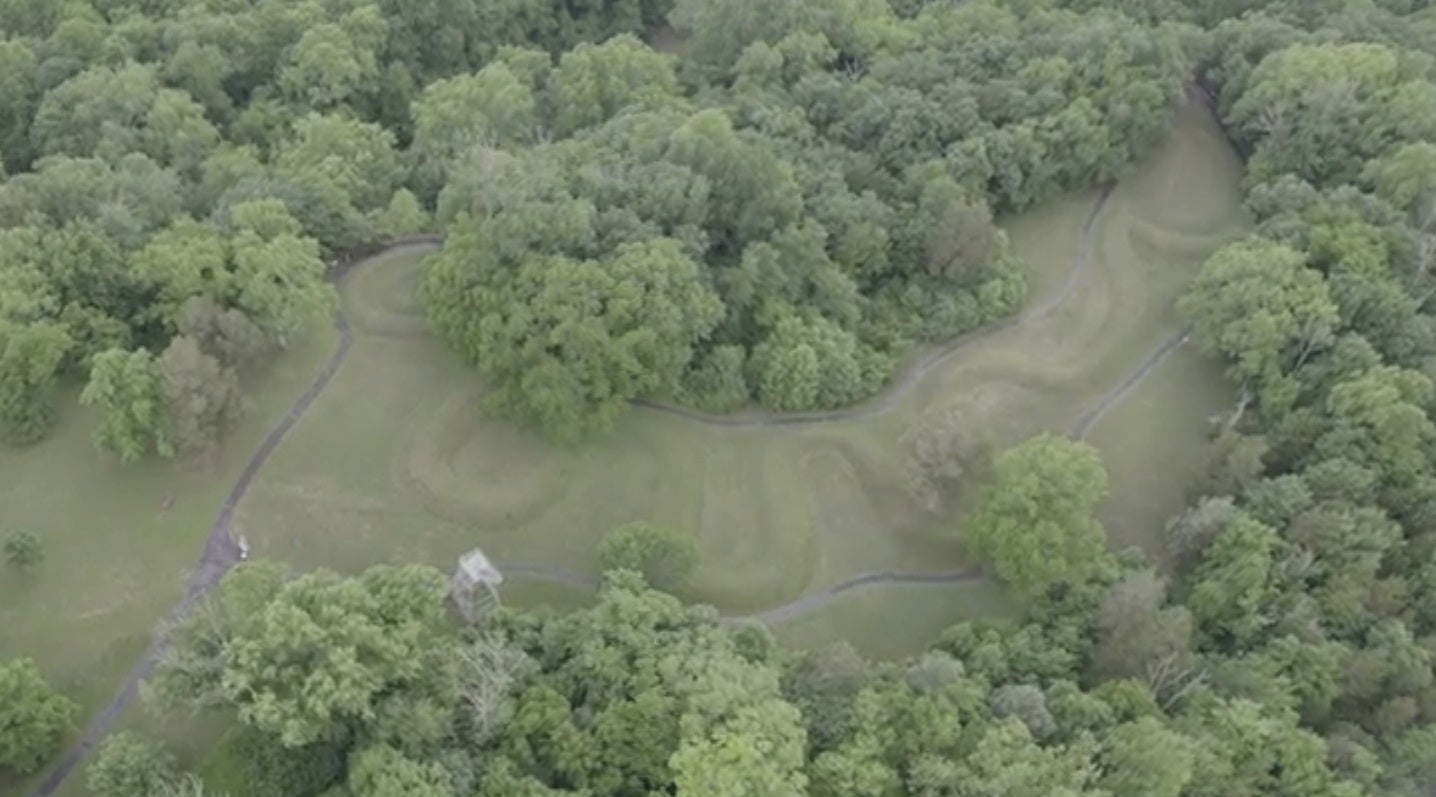Archaeologists have discovered one of the world’s largest collections of ancient art, showing giants and monsters walking the Earth.
In a remote area of South America, a British-led research team has discovered more than a thousand prehistoric engravings – including the world’s largest examples of prehistoric rock art. However, the archaeologists believe that the examples found so far are only the “tip of a vast ancient artistic iceberg” – and that many more still await discovery.
It’s thought likely that the thousand-square-mile area (the size of Dorset) may well contain around 10,000 ancient engravings. The largest discovered so far is a 43-metre-long engraving of a giant serpent. Others portray giant centipedes, larger-than-life animals – and immense 10-metre-tall human-like figures.
The engravings – discovered along the Colombia/Venezuela border – portray everything from stingrays and vultures to monkeys and crocodiles, from dogs and jaguars to turtles and frogs.
There are also a large number of geometric engravings (mainly concentric circles, grid patterns and dot-filled triangles), representing as yet unidentified objects.
It’s one of the biggest concentrations of rock art in the world – rivalling others such as the French Dordogne region, Alpine northern Italy, Western Australia, and South Africa in terms of volume.

But by far the most unusual aspect of the engravings is the uniquely monumental nature of some of them. Around 60 of the 1,000 discovered so far have dimensions in excess of 10 metres. As well as the 43-metre serpent, they include two 10-metre-tall human-like figures (which could be spirits, or gods, or possibly shamans), an 11-metre-long centipede, and what is probably a four-metre-tall giant insect (potentially a butterfly).
“Our field research in Colombia and Venezuela is, for the very first time, revealing a previously largely unknown and unrecorded ancient culture in this remote part of South America,” said one of the project’s leaders, Dr Philip Riris of Bournemouth University’s department of archaeology and anthropology. “We hope that this will allow the modern world to appreciate the long-lost artistic and other achievements of the people who lived there many centuries before European colonisation,” he added.
The giant snakes (seven of them, measuring between 16 and 43 metres in length) are particularly significant because they may be part of a much wider global “mega-serpent” tradition.
Academic research published by numerous scholars over the years suggests that, unlike most other animal-related religious belief systems, snake worship, known to anthropologists as ophiolatry, was once a major worldwide phenomenon. It featured (and in some cases still features) in religious systems and mythologies in virtually every part of the world – from prehistoric Europe and ancient Egypt to Aboriginal Australia and ancient America.
Classical Greek mythology was rich in supernatural snake monsters and other snake-related beings, as was ancient Middle Eastern, European, Mexican, African, Chinese, Japanese and Indian mythology.

Serpents were often associated with the creation of humanity or of particular tribes; with immortality; and with the curing of disease. Depending on the culture, they can be regarded as benevolent or evil (or as capable of being both) – and were sometimes even seen as symbols of royalty.
The unusually wide global distribution of snake mythology and religious iconography suggests that the phenomenon is extremely ancient – and that humans worldwide have, for potentially tens of thousands of years, felt compelled to specifically placate and revere serpents. That is almost certainly because snakes posed (and still pose) a greater threat to humans than any other animal (apart from disease-carrying insects).
Still today, around 20,000 people die every year from venomous snake bites (compared with just 100 per year from lion attacks and 500 per year from encounters with crocodiles). What’s more, another 400,000 or so people are bitten and envenomed by snakes every year, even if they don’t die.

In ancient times, when humans lived much closer to the natural environment (and continually hunted and gathered in that environment), snakes were almost certainly, proportionately, an even greater threat to humanity – a threat that needed to be appeased and therefore worshipped, revered and placated.
As with the newly discovered Colombian and Venezuelan examples, other ancient cultures often portrayed serpent deities or spirits as truly monumental giant creatures. In California, Ohio, Peru and elsewhere, there are portrayals of truly gargantuan serpents writhing across local landscapes. The biggest, a vast 900-year-old 411-metre-long earthwork representing a giant snake, can still be seen on a hilltop in southern Ohio.

The newly discovered Colombian engravings were made by ancient Native American people – probably between around 700 and 1000 AD. They are among the most difficult-to-access examples of outdoor prehistoric art in the world. That’s because the prehistoric artists who engraved them often did so high up on near-vertical cliff faces. It would have been challenging, difficult and dangerous work.
The 43-metre-long giant serpent, for instance, is located three-quarters of the way up a 200-metre-high cliff. Some evidence suggests that, in ancient times, it functioned as an oracle – allowing the serpent to “speak” to the local population, through a shaman or other intermediary (much as oracles worked in other parts of the world, including ancient Greece and ancient Egypt).
The thousand engravings so far discovered by the archaeological team are located in 157 clusters along a 110-mile stretch of the Orinoco River. The first European explorers to penetrate the region were 16th-century German and English treasure-hunters, searching for the fabled gold of El Dorado. Those adventurers (including England’s Sir Walter Raleigh) never found the legendary city, or the gold. But now, modern explorers have succeeded in discovering an archaeological treasure trove – giant artworks that will help change the academic world’s understanding of a remarkable long-lost ancient culture.
“We hope that our research work will help ensure that the extraordinary artistic heritage of the Orinoco valley is protected, and that local indigenous and mixed-heritage communities will become involved in that process,” said Riris.
A groundbreaking paper, devoted entirely to describing the newly recorded and globally important Orinoco rock art, is being published on Tuesday – written by the Orinoco project’s three main archaeologists: Philip Riris of Bournemouth University, Jose Ramon Oliver of University College London, and Natalia Lozada Mendieta of the University of the Andes in Bogota, Colombia. Published by the scholarly UK-based archaeological journal Antiquity, it will be available free online.

